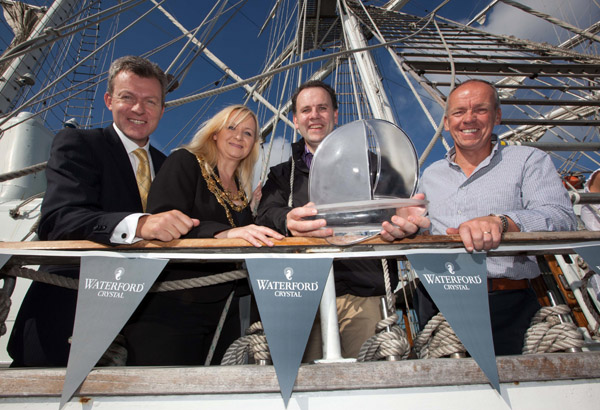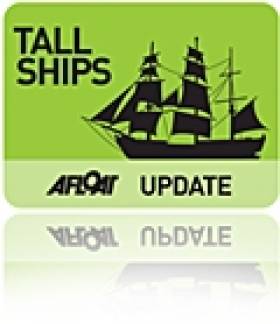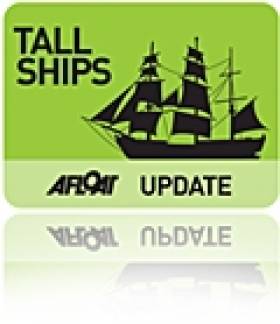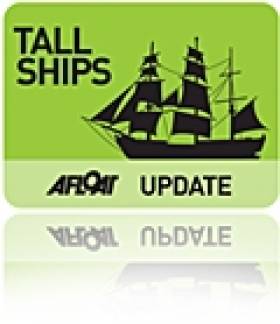Displaying items by tag: Tall Ships Races
Tall Ships Will Sail to Dublin in 2012
It's official - the Tall Ships Races will be coming to Dublin in August next year!
As the Evening Herald reports, the successful four-day festival in Waterford this past weekend will be repeated in the capital from 23-26 August 2012, with up to 100 tall ships expected to sail up the mouth of the Liffey.
As keen readers of afloat.ie will already know, news of the Dublin event was published here back in March.
The event is hoped to attract more than a million visitors to the city, topping the 500,000 spectators who thronged Waterford from last Thursday to Sunday.
Young sailing trainees from Dublin will also have the opportunity of a lifetime to work on board the vessels.
Tall Ships Races Could Mean Big Money for Waterford
This weekend's Tall Ships Races in Waterford could bring in up to €35 million to the local economy, according to Fáilte Ireland.
Gerry Breen of Fáilte Ireland also told The Irish Times that the event would complement the new Viking Triangle development in the city, which is hoped to be a major tourist attraction.
Des Whelan, chairman of the Waterford Tall Ships Race 2011, said the official website had registered nearly 200,000 hits, and hotels in the city are almost completely booked out.
Opening the weekend's festivties this evening are a fashion show on board the Russian sailing ship Mir, and a special concert by Roxy Music singer Bryan Ferry.
The first of three impressive fireworks displays will also light up Waterford's skies at 10.30pm tonight.
50 Facts About the Tall Ships Races 2011
Ahead of the Tall Ships Races in Waterford which begin tomorrow, Waterford Today presents 50 facts you may not be aware of regarding the annual event and its host city for 2011.
Did you know, for instance, that Waterford was once home to some of the most sophisticated shipbuilding operations of the 19th century, and was this country's leading location for iron shipbuilding from the mid-1840s to the early 1860s?
Or that the 55-metre barque Europa, from the Netherlands, is celebrating 100 years afloat in 2011?
Waterford Today has more interesting facts about this year's races HERE.
Black Diamond Ready for Success at Tall Ships Races
The Hartlepool Mail reports on one skipper who's making final repairs to his vessel ahead of the Tall Ships Races in Waterford this month.
Calvin Whitehead, captain of the 45ft Black Diamond, will set sail next Monday from Hartlepool with a crew of nine young people who will have the chance to gain valuable sailing experience.
The 29-year-old is hoping to repeat the class C ship's results in last year's race, where it finished second in its category.
"The boat is in good nick and the crew has mostly sailed before. We have a pretty good chance this year," he said.
The Tall Ships Races kick off in Waterford from 30 June to 3 July before the fleet sets sail for the Shetland Islands, then Stavanger in Norway and finally Halmstad, Sweden in August.
Collaboration with other sail training bodies to establish a regular Tall Ships festival in Ireland is one of the long term goals of Sail Training Ireland's new youth development manager.
As previously reported on Afloat.ie, Michael Byrne took up the new post at Dublin Port last week. His first tasks include fundraising, planning structures for membership, administering bursaries for sail training experience and preparing for the Tall Ships visit to Waterford next month.
But he has also signalled his intent in the long term to "co-operate and engage with other sail training associations and organisations with the view to establishhing a recurring STI-endorsed Tall Ships maritime festival every three-to-five years."
Byrne also hopes to sponsor and support sail trainees on boats around the world to give them invaluable experience at sea.
For more information visit www.irishsailtraining.com.
Requirements for Recreational Craft at Tall Ships Races
The latest Marine Notice from the DTTAS includes important information for recreational craft expected to attend the Tall Ships Races in Waterford from 30 June to 3 July.
Race organisers and the Waterford harbour master have issued an approved water safety plan for the marshalling of spectator boats for the time the tall ships are in port and for the start of the race off Hook Head.
Skippers and crew must comply with all instructions and be aware of their obligations under existing maritime legislation (regarding avoidance of collisions, preventing reckless behaviour and ensuring correct safety equipment is on board).
Boat owners intending to visit should contact the harbour master for details on restricted areas and berthing spots via the Port of Waterford website or directly at 051 974 907.
Restrictions are also in place for passenger boats and ships. Only fully licenced vessels with plying limits listing Waterford as a point of departure are allowed to operate during the event. Temporary changes in plying limits can be made via the Marine Survey Office before 15 June.
Further details are available on Marine Notice No 28 of 2011 which is available to read or download HERE.
Reviving the Age of Steam for Waterford's Tall Ships
In The Irish Times on Thursday, Tim Sweetman from Islandbridge writes that steam trains could add a touch of old-fashioned glamour to the Tall Ships Races in Waterford this summer.
"Perhaps Irish Rail and the Railway Preservation Society might come together to provide more atmosphere," he suggests. "There's a perfectly good line available from Waterford to Rosslare that is looking for some business."
What else could be done to make the most of the Tall Ships visit? Make your own suggestions in the comments below!
Waterford Businesses Want Fair Pricing at Tall Ships
Waterford's business and tourism leaders have demanded "fair pricing" in the city during the Tall Ships Races this summer, The Irish Times reports.
Reports have circulated that local hotels and other businesses were planning to raise their prices for the half-million visitors expected to descend upon the south coast city at the end of June.
But Fáilte Ireland, Waterford Chamber of Commerce and Mayor Mary Roche are backing a fair-price initiative, urging the city's many shops, cafes, restaurants, bars and tourist attractions to offer value for money.
Mayor Roche said the hosting of the Tall Ships Races was "a priceless opportunity" to showcase Waterford on an international stage.
The Irish Times has more on the story HERE.
Setting Sails for Waterford's Tall Ships Race
The four-day maritime spectacle expects to attract 500,000 visitors to throng the quays of the 'Crystal' city. Presented by Szczecin and organised by Sail Training International, the prestigious event is supported through host-port partners, 3, Bulmers Original Irish Cider and Waterford Crystal. In addition the host-port educational partner is Waterford Institute of Technology and the official media partner covering the event is RTE. Between them over €450,000 has been raised to support funding.
Waterford City Council and the Port of Waterford are providing leading roles as delivering agencies having jointly mounted the bid to secure staging the Tall Ships Races return following the city's successful hosting of the event in 2005.
Notably in that year's 'Parade of Sail' the procession was led by Asgard II, followed astern by Jeanie Johnston and Dunbrody. The involvement of all Irish tall-ships was an historical occasion particularly in view of the sinking of Asgard II three years later.
In 2005, Waterford also claimed to be the first Irish host port to be the starting port for the race and this will be repeated in 2011.

Gary Breen, Failte Ireland; Cllr Mary Roche,Mayor of Waterford,David McCoy, House of Waterford Crystal and Des Whelan, Chairman, The Tall Ships Races 2011 onboard the 'Lord Nelson' in Waterford. Photo: Dylan Vaughan
At the reception onboard Lord Nelson, Cllr Mary Roche, Mayor of Waterford said: "To 3,Bulmers,RTE, Waterford Crystal and Waterford Institute of Technology, I say a very sincere thank you on behalf of the people of Waterford and all of those around Europe and beyond who will be here next summer for what promises to be four magical days of free fun in Ireland's oldest city".
Next year's hosting is also to be supported by Failte Ireland which is allocating resources of €3m while Tourism Ireland will embark on an intensive marketing campaign during the mid summer event, which is billed to be the biggest event in Ireland.
There will be between 80-100 tall-ships and their international crews converging in Waterford. Among the vessels confirmed is the 1937-built, Christian Radich which starred in the 1958 film, The Windjammer and also featured in the 1970's television series, The Onedin Line.
Incidentally the Christian Radich was used, albeit with limited trainee spaces allocated to Coist an Asgard in an arrangement with the vessel's Norwegian owners in 2009, the first full year of the national sail training programme since the sinking of Asgard II the previous year.
The staging costs of the 2011 Tall Ships is estimated at €3.5m and is expected to generate €35m to Waterford City and hinterland. The organisers of the event will be embracing social technology communications networks with presentations on Facebook, Twitter and other servers.
Last year Belfast held the honour in welcoming the finale of the Tall Ship Races, incorporating the Tall Ships Atlantic Challenge. Dublin hosted the event in 1998, albeit the race was then known as the Cutty Sark Tall Ships Race with this same title applying to the race when the event visited Cork Harbour in 1991.
Looking for further reading on Tall Ships in Ireland? Click the links below:
Click this link to read all our Tall Ships Stories on one handy page
Previewing Ireland's Tall Ships 2011 Season
Can Ireland Get a New Tall Ship?





































































